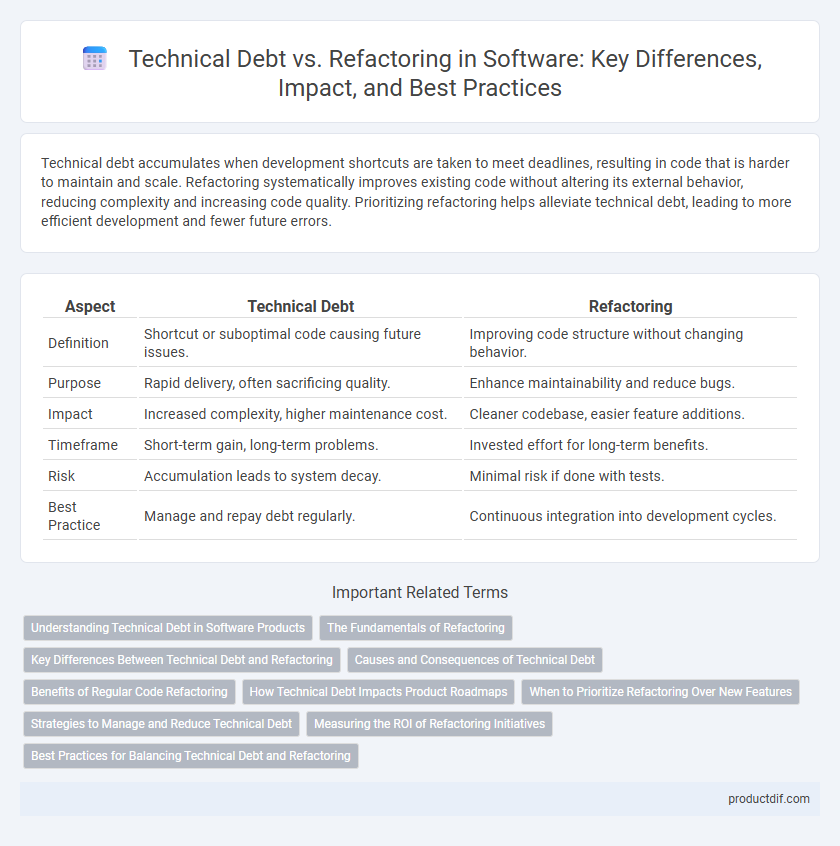Technical debt accumulates when development shortcuts are taken to meet deadlines, resulting in code that is harder to maintain and scale. Refactoring systematically improves existing code without altering its external behavior, reducing complexity and increasing code quality. Prioritizing refactoring helps alleviate technical debt, leading to more efficient development and fewer future errors.
Table of Comparison
| Aspect | Technical Debt | Refactoring |
|---|---|---|
| Definition | Shortcut or suboptimal code causing future issues. | Improving code structure without changing behavior. |
| Purpose | Rapid delivery, often sacrificing quality. | Enhance maintainability and reduce bugs. |
| Impact | Increased complexity, higher maintenance cost. | Cleaner codebase, easier feature additions. |
| Timeframe | Short-term gain, long-term problems. | Invested effort for long-term benefits. |
| Risk | Accumulation leads to system decay. | Minimal risk if done with tests. |
| Best Practice | Manage and repay debt regularly. | Continuous integration into development cycles. |
Understanding Technical Debt in Software Products
Technical debt in software products represents the implied cost of additional rework caused by choosing an easy, limited solution instead of a better approach that would take longer. Accumulating technical debt can degrade code quality, increase maintenance costs, and slow down future development cycles. Refactoring is the systematic process of improving code structure without changing its external behavior, which helps manage and reduce technical debt over time.
The Fundamentals of Refactoring
Refactoring is the disciplined process of restructuring existing code without changing its external behavior, aimed at improving code readability, maintainability, and extensibility. It targets the reduction of technical debt by addressing code smells such as duplicated code, long methods, and complex classes, which degrade software quality over time. Effective refactoring relies on automated testing frameworks to ensure that functionality remains intact while incrementally enhancing the codebase architecture.
Key Differences Between Technical Debt and Refactoring
Technical debt refers to the accumulation of suboptimal code or shortcuts taken during software development that can slow down future progress and increase maintenance costs. Refactoring involves restructuring existing code to improve its readability, maintainability, and performance without changing its external behavior. While technical debt represents a liability that hinders development, refactoring is a proactive practice aimed at reducing that debt and enhancing code quality.
Causes and Consequences of Technical Debt
Technical debt arises from rushed coding, lack of proper documentation, and shortcuts taken to meet tight deadlines, leading to complex and error-prone codebases. Consequences include increased maintenance costs, reduced software quality, and slowed feature development due to the need for constant fixes and workarounds. Refactoring addresses these issues by systematically improving code structure without altering its functionality, thereby reducing long-term technical debt and enhancing code maintainability.
Benefits of Regular Code Refactoring
Regular code refactoring reduces technical debt by improving code readability, maintainability, and performance, which decreases the risk of bugs and accelerates future feature development. It enables developers to identify and address design flaws early, ensuring scalable and robust software architecture. Continuous refactoring fosters a cleaner codebase that supports efficient collaboration and easier integration of new technologies.
How Technical Debt Impacts Product Roadmaps
Technical debt accumulates when quick fixes or suboptimal solutions are chosen over ideal implementations, leading to increased maintenance costs and slower development cycles. This backlog of unresolved issues creates resource constraints that delay feature releases and disrupt product roadmap timelines. Consistently managing technical debt through strategic refactoring ensures teams can meet long-term goals without sacrificing innovation or product quality.
When to Prioritize Refactoring Over New Features
Prioritize refactoring over new features when technical debt significantly hampers code maintainability, increases bug frequency, or slows down development velocity. Elevated code complexity metrics and a high defect rate indicate that addressing debt will reduce long-term costs and improve product stability. Allocating development resources to refactoring creates a solid foundation, enabling faster and safer future feature enhancements.
Strategies to Manage and Reduce Technical Debt
Effective strategies to manage and reduce technical debt include prioritizing refactoring based on impact and risk, implementing continuous integration and automated testing to detect issues early, and maintaining comprehensive documentation to improve codebase maintainability. Regularly scheduled code reviews and allocating dedicated time within sprints for refactoring tasks help prevent technical debt accumulation while enhancing software quality. Leveraging metrics such as code complexity and code churn provides actionable insights for targeted refactoring efforts.
Measuring the ROI of Refactoring Initiatives
Measuring the ROI of refactoring initiatives involves quantifying improvements in code maintainability, reduced bug rates, and faster feature delivery times, which directly correlate to decreased technical debt over time. Key performance indicators include reduced mean time to resolution (MTTR), lower defect density, and increased developer productivity, providing measurable evidence of refactoring benefits. Incorporating tools like static code analyzers and continuous integration metrics enhances accuracy in assessing the financial and operational returns of refactoring efforts.
Best Practices for Balancing Technical Debt and Refactoring
Balancing technical debt and refactoring requires prioritizing high-impact areas where code quality directly affects system performance and maintainability. Implement incremental refactoring strategies during regular development cycles to minimize disruptions while systematically reducing technical debt. Employ automated code analysis tools to identify debt hotspots and enforce coding standards that prevent new debt accumulation.
Technical Debt vs Refactoring Infographic

 productdif.com
productdif.com